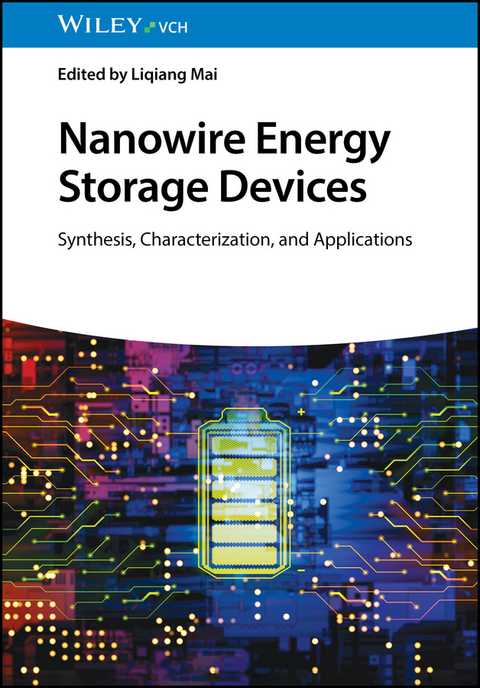Nanowire Energy Storage Devices
Wiley-VCH (Verlag)
978-3-527-34917-3 (ISBN)
Liqiang Mai is Chair Professor of materials science and engineering at Wuhan University of Technology (WUT). He is Changjiang Scholar Professor and Distinguished Young Scholar of the National Science Fund of China. He received his PhD degree from WUT in 2004. He worked as an advanced research scholar at Harvard University from 2008-2011 and Prof. Peidong Yang's group at the University of California, Berkeley, in 2017.
1. INTRODUCTION
1.1 One-Dimensional Nanomaterials
1.2 Energy Storage Science and Technology
1.3 Overview of Nanowire Energy Storage Materials and Devices
2. FUNDAMENTALS OF NANOWIRE ENERGY STORAGE
2.1 Physical and Chemical Properties of One-Dimensional Nanomaterials
2.2 Thermodynamics and Kinetics of One-Dimensional Nanomaterials
2.3 Basic Performance Parameters of One-Dimensional Nanomaterials Electrochemical Energy Storage Devices
2.4 Interface Characteristics of One-Dimensional Nanomaterials
2.5 Optimization Mechanisms of Electrochemical Performance of One-Dimensional Nanomaterials
2.6 Theoretical Calculations of One-Dimensional Nanomaterials
2.7 Summary and Outlook
3. DESIGN AND SYNTHESIS OF NANOWIRES
3.1 Conventional Nanomaterials
3.2 Porous Nanomaterial
3.3 Hierarchical Nanomaterials
3.4 Heterogeneous Nanomaterials
3.5 Hollow Nanomaterials
3.6 Summary and Outlook
4. NANOWIRES FOR IN-SITU CHARACTERIZATION
4.1 In-Situ Electron Microscopic Characterization
4.2 In-Situ Spectroscopy Characterization
4.3 In-Situ Characterization of Nanowire Devices
4.4 Other In-Situ Characterization
4.5 Summary and Outlook
5. NANOWIRES FOR LITHIUM-ION BATTERIES
5.1 Electrochemistry, Advantages, and Issues of Lithium-Ion Batteries
5.2 Unique Characteristic of Nanowires for Lithium-Ion Batteries
5.3 Nanowires as Anodes in Lithium-Ion Batteries
5.4 Nanowires as Cathodes in Lithium-Ion Batteries
5.5 Nanowires-Based Separators in Lithium-Ion Batteries
5.6 Nanowires-Based Solid-State Electrolytes in Lithium-Ion Batteries
5.7 Nanowires-Based Electrodes for Flexible Lithium-Ion Batteries
5.8 Summary and Outlook
6. NANOWIRES FOR SODIUM-ION BATTERIES
6.1 Advantages, and Issues of Sodium-Ion Batteries
6.2 Nanowires as Cathodes in Sodium-Ion Batteries
6.3 Nanowires as Anodes in Sodium-Ion Batteries
6.4 Summary
7. NANOWIRES FOR LITHIUM-SULFUR BATTERIES
7.1 Advantages, and Issues of Li-S Batteries
7.2 Nanowires as Cathodes in Li-S Batteries
7.3 Nanowires as Anode in Li-S Batteries
7.4 Nanowires as Additives or Interlayers in Li-S Batteries
7.5 Summary and Outlook
8. APPLICATION OF ONE-DIMENSIONAL NANOMATERIALS IN SUPERCAPACITORS
8.1 Advantages of One-Dimensional Nanomaterials in Supercapacitors
8.2 One-Dimensional Nanomaterials for Electric Double Layer Supercapacitors
8.3 One-Dimensional Nanomaterials for Pseudocapacitive Supercapacitors
8.4 One-Dimensional Nanomaterials of Hybrid Supercapacitors
8.5 Summary and Outlook
9. NANOWIRES FOR OTHER ENERGY STORAGE DEVICES
9.1 Metal-Air Battery
9.2 Polyvalent Ion Batteries
9.3 Alkaline Battery
9.4 Sodium/Lithium-Sulfur Batteries
9.5 Summary and Outlook
10. CONCLUSION AND OUTLOOK
| Erscheinungsdatum | 21.04.2023 |
|---|---|
| Verlagsort | Berlin |
| Sprache | englisch |
| Maße | 170 x 244 mm |
| Gewicht | 754 g |
| Themenwelt | Naturwissenschaften ► Chemie ► Physikalische Chemie |
| Technik ► Maschinenbau | |
| Schlagworte | Batterien u. Brennstoffzellen • Batteries & Fuel Cells • Chemie • Chemistry • Energie • Energiespeicherung • Energy • Energy Storage • Nanodrähte • Nanomaterialien • nanomaterials • Nanotechnologie • nanotechnology |
| ISBN-10 | 3-527-34917-0 / 3527349170 |
| ISBN-13 | 978-3-527-34917-3 / 9783527349173 |
| Zustand | Neuware |
| Informationen gemäß Produktsicherheitsverordnung (GPSR) | |
| Haben Sie eine Frage zum Produkt? |
aus dem Bereich




